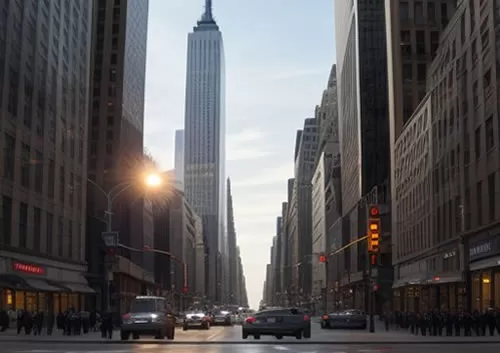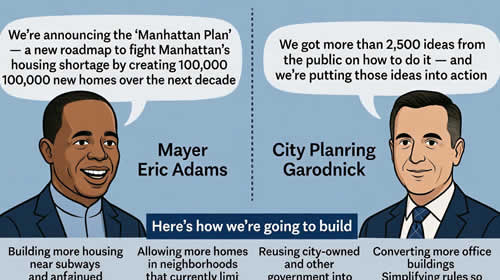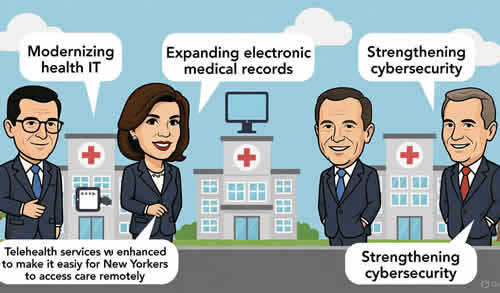New York City Mayor Eric Adams, in collaboration with the New York City Department of Health and Mental Hygiene and Cornell University, announced the inaugural National Urban Rat Summit for September 18 to 19, aiming to unite researchers and municipal experts to exchange best practices in rodent control. This summit aligns with the city’s comprehensive integrated pest management approach, which includes initiatives such as citywide coordination, garbage containerization, and targeted interventions to reduce rat populations and sightings.
Summit Will Bring Researchers, Municipal Rodent Control Experts Together to Share Best Practices
– New York City Mayor Eric Adams today announced that — in partnership with New York City Department of Health and Mental Hygiene (DOHMH) and the New York State Integrated Pest Management Program at Cornell University — New York City will host its inaugural National Urban Rat Summit this fall, from September 18 to 19. The summit will bring together a wide range of experts — from researchers at academic institutions to municipal pest control managers — to connect, share best practices on rodent mitigation, and advance the science of urban rat management. The summit will include participants from across the country, including municipal experts from Boston, New Orleans, and Seattle, as well as preeminent rat researchers from across the nation.
“New Yorkers may not know this about me — but I hate rats, and I’m confident most of our city’s residents do as well,” said Mayor Adams. “With rat sightings down nearly 14 percent in our city’s Rat Mitigation Zones year over year, we continue to make progress, but we’re not stopping there. The best way to defeat our enemy is to know our enemy. That’s why we’re holding this inaugural summit, to bring experts and leaders from across the country together to better understand urban rats and how to manage their populations.”
“Despite being our closest urban counterparts, there is surprisingly limited research on urban rats and their management,” said Citywide Director of Rodent Mitigation Kathleen Corradi. “New York City is a vanguard in municipal rat management and continues to drive citywide mitigation efforts using science and data. We are proud to host the National Urban Rat Summit as a dedicated step to deepening understanding and building better sustainable management.”
“Under Mayor Adams’ leadership, New York City is taking the fight to the rats, enacting proven strategies that have been delayed by inertia for too long — and getting results, with rat sightings down 12 of the 13 months since we began the Herculean task of getting all 44 million daily pounds of rat-attracting trash off the streets,” said New York City Department of Sanitation (DSNY) Commissioner Jessica Tisch. “The Urban Rat Summit is an opportunity to share best practices as the ‘Trash Revolution’ marches forward.”
“As the nation’s largest school system, we are regularly collaborating with cities and school districts around the country, in service of our youngest New Yorkers,” said New York City Department of Education (DOE) Chancellor David C. Banks. “As a major player in the effort to mitigate rats across the five boroughs, we look forward to collaborating with our partners around the nation, improving the livability of our city for our kids and all New Yorkers.”
“NYCHA has made tremendous progress in our rat mitigation efforts by focusing on increasing staffing and training, as well as investing in more efficient equipment and utilizing more effective methods,” said New York City Housing Authority (NYCHA) Chief Executive Officer Lisa Bova-Hiatt. “With pests being one of the pillar areas of the 2019 U.S. Department of Housing and Urban Development Agreement, we are extremely dedicated to the removal of rodents from NYCHA properties and take pride in the dramatic decline we’ve seen in the number of rat burrows at developments included in the city’s Neighborhood Rat Reduction Plan over the past five years. We look forward to participating in the inaugural National Urban Rat Summit later this year and collaborating with other pest mitigation experts.”
“Reducing the rodent population is essential to making cities healthier and more sanitary, while maintaining a healthy urban ecosystem,” said New York City Department of Parks and Recreation (NYC Parks) Commissioner Sue Donoghue. “New York City is laser-focused on rat control and we’re grateful to Mayor Adams and Cornell University for spearheading this summit that will advance best practices and allow cities from across the nation to collaborate on ways to keep rats on the run.”
“As New Yorkers know too well, rats aren’t just gross, they can make your home unlivable. By bringing together the greatest minds at the first National Urban Rat Summit, we take a crucial step toward significantly reducing the rat population,” said New York City Department of Housing Preservation and Development Commissioner Adolfo Carrión Jr. ”This administration’s commitment to advancing the ‘Trash Revolution’ will help us accomplish our number one objective: to prioritize the well-being of New Yorkers and protect tenants and homeowners.”
“New York City has long been a pioneer of urban rat control, and we’re always up for an exchange of ideas,” said DOHMH Assistant Commissioner of Veterinary and Pest Control Services Mario Merlino. “Winning the rat race is a core part of keeping our city livable and we look forward to sharing Health Department successes — including our proactive neighborhood rat reduction approach, our free rat academies, and our collaboration with other agencies and research institutions.”
“Rats are a common yet despised aspect of urban life. They cause loss of business, structural damage, and pose public health risks,” said Matt Frye, Ph.D., senior extension associate, New York State Integrated Pest Management Program, Cornell University. “Municipalities are charged with managing rats on a large scale, but there are only a handful of technical resources intended for this important audience, and subject area experts are similarly rare. This summit is a leap forward for urban rat management, forging new relationships between municipalities and academic partners.”
The summit comes as New York City continues to make progress in implementing a holistic integrated pest management strategy, focused on identifying rat hotspots and removing conditions that allow rats to thrive. In April 2023, Mayor Adams appointed Kathleen Corradi as citywide director of rodent mitigation and announced the new Harlem Rat Mitigation Zone, the city’s fourth dedicated zone. Director Corradi has played a vital role in developing, coordinating, and executing rat mitigation efforts across city agencies, in addition to different private-sector partners.
Included in that strategy is the city’s efforts, led by DSNY Commissioner Tisch, to containerize all 14 billion pounds of trash that the city currently produces every year. For decades, that trash sat on the street in black plastic bags for as long as a full day at a time, attracting rats and stinking up New York City neighborhoods. The Adams administration rejected that status quo and has already implemented DSNY rules requiring that all 7 billion annual pounds of business trash go into containers. Later this fall, when container requirements go into effect for low-density residential buildings — those with one to nine units — approximately 70 percent of all trash in the city will be containerized. Additionally, the administration developed an all-new, automated, side-loading garbage truck that will allow the city to containerize trash from high-density buildings using stationary on-street containers. As a result, Manhattan Community Board 9 will be the first district with 100 percent of its trash containerized and serviced next year.
Additionally, NYC Parks is implementing a robust approach to rat control in the city’s parks, with the goal of addressing the underlying conditions that support rat colonies. As a part of their effort to significantly decrease rats in parks with high burrow counts, NYC Parks will continue to limit access to potential food sources by rodents and target the places where they burrow.
Further, DOHMH conducts proactive inspections and complaint inspections enforcement. The agency uses a targeted strategy that extends to Rat Mitigation Zones, where city agencies focus resources to address rats and the conditions that support them. Other efforts to reduce rat activity range from technical assistance, to extermination, to education, to public engagement.
There are currently four DOHMH-established Rat Mitigation Zones that encompass nearly 200 New York City public school buildings. DOE efforts have included two distinct but collaborative pieces: extermination and waste operations. Rodents are addressed through extermination services as well as support for proper waste management procedures at each impacted school to reduce conditions conducive to rats.
Finally, NYCHA has designated 45 exterminators to treat NYCHA public spaces and rolled out training on more efficient methods of treating grounds. They have also invested in more effective equipment that puts pesticides directly into rat burrows, as well as non-pesticide mitigation methods like carbon dioxide tanks, carbon monoxide-based Burrow Rx machines, and snap traps. Additionally, they have launched an exclusion team that seals window vents to basements and a rat burrow collapse team that collapses rat burrows, aiding in the prevention of mating and overall tracking of active rat colonies.
As a result of the administration’s broader integrated pest management approach, rat sightings reported to 311 continue to decline. Rat sightings have decreased in 12 out of the 13 months since the administration kicked off its revolutionary efforts to get trash off the streets and since Mayor Adams appointed Kathy Corradi as director of citywide rodent mitigation. The total decrease across the covered period was 6.3 percent and almost 14 percent in the city’s Rat Mitigation Zones.
May 15, 2024 New York
Here are some potential critiques and suggestions for how Mayor Eric Adams could better approach the issue of rat control in New York City:
QUESTIONABLE USE OF FUNDS
- Hosting a national summit seems like an unnecessary expense when those funds could be better directed towards actual rat control efforts on the ground.
- Bringing in outside researchers and experts from across the country is costly and may not provide solutions tailored to NYC’s unique urban environment.
- The money would be better spent on increasing the budget for the city’s existing integrated pest management programs.
LACK OF TRANSPARENCY
- There is no information provided on the expected costs or budget for this summit, raising questions about fiscal responsibility.
- The public deserves to know how much of their tax dollars are being allocated to this event versus tangible rat mitigation efforts.
FOCUS ON PREVENTION
- Rather than reacting with summits, the city should prioritize proactive measures like improved sanitation, better waste management, and public education campaigns.
- Addressing the root causes that allow rat populations to thrive, such as access to food sources and harbourage, would be more effective long-term.
COMMUNITY INVOLVEMENT
- The summit appears to be a top-down approach, when community engagement and buy-in are crucial for sustainable rat control.
- Funds could be better used to empower local communities, businesses, and residents to take ownership and implement preventative measures.
PROVEN SOLUTIONS
- Instead of seeking new “best practices,” the city should double down on strategies that have already demonstrated success in reducing rat infestations in NYC and other major cities.
- Investing in tried-and-true methods like improved garbage management, structural repairs, and targeted baiting would be a wiser use of resources.
Here are some alternative methods and approaches cities can use for rat control that do not involve harmful poisons:
- Encourage Natural Predators
- Erect nesting boxes for birds of prey like barn owls and tawny owls, which feed on rats. Place them as close as possible to areas with high rat activity.
Utilize Domestic Predators
- Encourage residents to use certain breeds of dogs, like Jack Russell terriers, that are skilled at hunting and killing rats. This provides a quick, humane method of control.
The underlying message is that while the summit’s intentions may be well-meaning, the allocated funds could potentially achieve greater impact if directly invested in proven, preventative, and community-driven rat control efforts tailored to New York City’s needs.
Sources : Midtown Tribune news – NYC.gov
Big New York news BigNY.com










